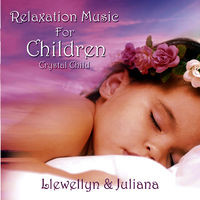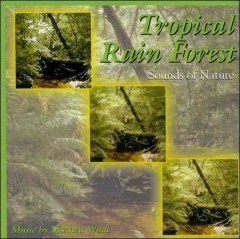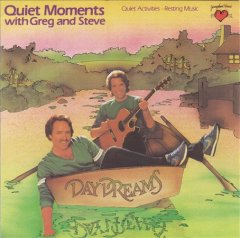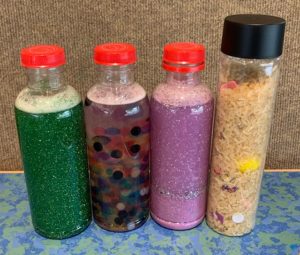
Sensory bottles are a great way to help your mind calm down and relax. There are so many different ways to create your own, and they are really easy to make, requiring minimal supplies. For the bottle, you can purchase a nice clear bottle specifically for this project, or you can do what I did and reuse a beverage bottle. I used Bai bottles for most of mine because I like how they are sturdy and smooth. Some water bottles are super thin and flimsy so they won’t hold up well to sensory exploration.
The base can be created with a variety of liquids. You can use glitter glue, clear hair gel, corn syrup, clear tacky glue, hair conditioner, clear liquid soap or glycerin. Adding one of these ingredients helps the other items you put in your bottle float better instead of immediately settling to the bottom after being shaken. Since each one of these items has different properties, results may vary. Make sure you do not fill it completely to the top with liquid. You need to leave some space at the top so there is room for the liquid to move around a little. Once you have your bottle made to your liking, I highly recommend using hot glue or super glue to seal the lid closed. You don’t want to shake it with a loose lid!
I wanted to try making a few different kinds of sensory bottles to see what I thought worked the best.
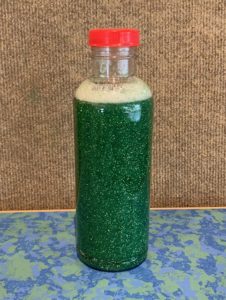
Glitter
Supplies Needed:
- Clear glue
- Warm Water
- Glitter
I think this one is my favorite! I filled the bottle with half glue, half warm water. Warm water helps it mix better with the glue. Shake it up to mix the glue and water. Add however much glitter you want. When it sits for a while, the glitter will settle at the bottom with the glue, so you’ll really need to shake vigorously to get it all swirling again. It is so mesmerizing to watch the swirls of glitter!
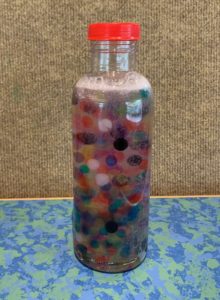
Water Beads
Supplies Needed:
- Water Beads
- Clear shampoo
- Water
I mixed ¼ shampoo with ¼ water and shook it to mix it up. Once it settled, I added water beads and more water to fill it up. I used a clear shampoo because that is what I had. I’ve seen recommendations for using clear hair gel. Next time I would go for the hair gel because the shampoo got sudsy when shaking it up, which detracted from the visual of the water beads. I also felt like there weren’t enough water beads in it, and after a day or two, I poured out some of the liquid and added more water beads.
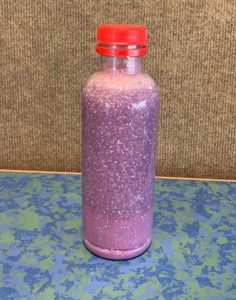
Weighted Sensory Bottle
Supplies Needed:
- Water
- Sand
- Glass stones
- Glitter
- Clear Glue
Pour sand into the bottom of the bottle about ¼ full. Add a layer of glitter. Add glass beads or stones. Pour in warm water to fill about ½ of what is left, and add clear glue for the rest. Shake well. Because the sand and glue settle at the bottom, it does require some vigorous shaking to dislodge it. The sand and stones add an auditory component as the glass beads and sand slide in the bottle, and the extra weight will make your muscles work harder, so you’re getting input into your arms as well.
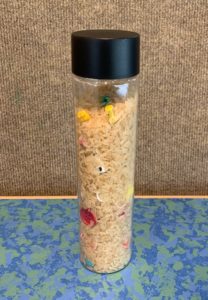
Rice Bottle
Supplies Needed:
- Rice (plain rice is good, but you can also color the rice for additional fun)
- Small objects/toys (Erasers, paper clips, beads, buttons, golf tees, push pins, dice, pom poms, googly eyes, letters, Legos, bingo chips, candles, safety pins)
Of course, not all sensory bottles need to be water based. Here is one that I made using rice. This is a homemade version of the game Find It or I Spy. I recommend making a list of all the objects that you put in with the rice. After shaking your bottle and getting everything good and mixed up, you can see if you can find all the objects on the list.
What senses are active with sensory bottles?
- Visual: Watch as the glitter, sand or water beads move and swirl with the water mixture, or look carefully so you can find the objects hidden in the rice.
- Tactile: Your bottle may have bumps and ridges on it that you can feel as you shake the bottle. Depending on what you have inside your bottle, you might even be able to feel objects moving.
- Auditory: Can you hear the objects inside your bottle moving and bumping into other objects?
- Proprioceptive: This is the sensory input you feel in your muscles and joints. If you make a weighted bottle, you have to work a little harder to shake it, and if you have glue mixed in, you have to shake extra hard to get everything dislodged to swirl around.
We also have a wide variety of music options that would be perfect to enjoy while relaxing with a sensory bottle. You can try one of the following CDs:
Relaxation Music for Children by Llewellyn & Juliana
The duo of Llewellyn & Juliana wrap young listeners in a blanket of blissful melodies, dreamy synths, soft twinkling tones and gentle vocals. The end result is an atmospheric effect that is perfect for creating a calming environment.
Find it now
Tropical Rain Forest: Sounds of Nature
Enjoy soothing nature sounds from the rain forest.
Find it now
Quiet Moments with Greg and Steve by Greg and Steve
A collection of resting songs, coupled with relaxation activities.
Find it now
If you prefer to stream your music, you can use our digital collection to find music for meditation on hoopla or ambient music on Freegal.

